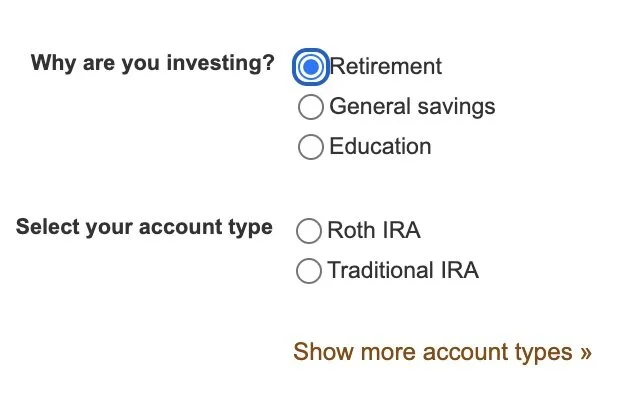Your step-by-step guide to opening a retirement account.
One more time for the people in the back: the sooner you start saving for retirement the more money you’ll have when you retire (refresher, if you missed it). Since we’re all about taking real steps, here are the actual 1-2-3 steps to get that going.
For a retirement account offered by your employer like a 401(k) or ROTH 401(k): The company gives you all the necessary information. Typically each employer has a specific account provider (e.g. Fidelity, Vanguard). Best place for more info? That HR department.
For a personal retirement account like an IRA or ROTH IRA: You can open one on MOST investing platforms (including your bank)! PSA: Robinhood makes trading easy but doesn't offer any retirement accounts to invest in.
What you need to open an online account will look very familiar if you've opened that starter investment account. Main difference? The button you click when you open your account:
Step 1: Start with your 401(k) - if your company offers one
Max out your contributions (fancy way of saying “contribute the limit” which is $19,500 per year). If you can’t swing that amount being taken from your paycheck (i.e. you need cash to keep life afloat), then contribute the amount that gets you your employer-match.
Fun fact: Companies use formulas to determine how much of your contributions they’ll match, but a standard example could be they match 50 cents of every dollar you contribute, up to 6% of your salary.
Step 2: Open a ROTH IRA
If you still have some flush cash left over each year and are making under $139,000/year , you can open a ROTH IRA. Why? Unlike traditional IRAs, there’s no required minimum distributions (translation: you don’t HAVE to withdraw X amount by a certain age), and since ROTHs are post-tax contributions in your earning years, you don’t pay income taxes on withdrawal in your retirement years.
Benefits of being young include no real hangovers, breakfast for dinner is still acceptable, AND room to take some risk in your investments because of your longer investing time horizon (AKA years before you’ll need to tap that money).
Bottom line… While you're young, go for wealth creation and go nearly all in on stocks. Once you approach retirement, preserve the growth you’ve earned in your account and lean into bonds.
What does this mean? It means once you’ve opened your investment account and made your contribution (transferred money into it), you have choices in the funds/ETF world to invest your IRA. An example option is Vanguard All World. Our BEST tip for picking? Funds with low fees and no minimums.
You have 2 options:
Direct transfer to new 401(k)- Company A lets you transfer your 401(k) to Company B without penalties. Work with both companies to dot the i’s and cross the t’s to ensure it happens within the necessary time frame.
Open a rollover IRA - If your new gig doesn’t offer a 401(k) then open a “rollover IRA”. This means taking the money from your 401(k) and transferring it to a new IRA (company retirement plan to your own retirement plan). PSA: ensure it’s coded as a “rollover”, if that isn’t made clear to BOTH institutions you’ll owe tax.
Retirement is far away but it will feel THAT much sweeter from the pile you’ll be sitting on. Rules on when you can cash out (withdraw retirement funds to use) differ a bit depending on if it’s a 401(k) vs an IRA, but main thing to know — stay in the game as long as you can.


